Dianne Jacob's Blog, page 5
December 8, 2020
When the Social Media Attack Comes from Inside the House
 By Deborah Reid
By Deborah ReidCount your blessings if you’ve never been the target of a social media attack. I’ve been through that fire. Because sometimes I write about sexism and bros culture in the restaurant business, I expect it to happen again. “No one with a public platform and an opinion is doing his or her job effectively if they are not being attacked from time to time,” writes songwriter Nick Cave in his brilliant weekly Q&A newsletter, The Red Hand Files.
The universality of the experience can be hard to recall in the middle of an online ambush by strangers. It all feels so personal. But when it comes from a fellow food writer, it can mess with a person’s mental health and professional identity.
Food writers have done their part to rid the restaurant and publishing world of some high-ranking abusers and rapists. We’ve grown adept at recognizing toxic behavior in chefs and editors. But do we ever examine our whisper networks and how we show up in them with the same rigor? Or consider the psychological impact of quieter but no-less-offensive forms of bullying and harassment?
A Not-So-Secret Hater
Alicia Kennedy recently posted about a food writer taking shots at her on Twitter. The man replaced letters in her name with asterisks to avoid detection in search. “It made me worry there were a lot of people who thought I was full of shit or secretly hating on me.”
 Kennedy says, “A man doing this to a woman added to the cruelty in terms of the power dynamic.” You might stop and ask, “Who does this?” Maybe he was talking shit about her last week in your presence. Have you heard of the bystander effect? You’re an accessory if you’re riding shotgun. The responses to her question are beautiful and funny. And it’s a relief to see so many people jump in with support.* Besides, having a nemesis or two can be professionally beneficial.
Kennedy says, “A man doing this to a woman added to the cruelty in terms of the power dynamic.” You might stop and ask, “Who does this?” Maybe he was talking shit about her last week in your presence. Have you heard of the bystander effect? You’re an accessory if you’re riding shotgun. The responses to her question are beautiful and funny. And it’s a relief to see so many people jump in with support.* Besides, having a nemesis or two can be professionally beneficial.
The whisper network has its benefits. It can warn us of people who might not have our best interests at heart. But if the character assessment is based on heresy (sic) and not first-hand experience, how much should it color our opinion?
“The intention likely originates from a good place: look out, be warned, there is much to learn about this person. Yet, it establishes some personally anointed supreme judiciary position to the person doing the whispering that I find a bit…grotesque,” says author Lisa Donovan. “It also assumes the person being warned cannot judge the character of others.”
Great story leads often come when we spill a little tea with colleagues. But turning up in DMs or text groups regularly to gossip about others comes with reputational risks. It erodes trust and can quickly digress into pillaging the character of strangers. When I’ve gone there, remnants of it lodge in my body, and I can wake at night feeling uneasy and self-loathing. Toxic gossip is a bad habit, like smoking. With enough practice, it starts scanning for more brazen outlets.
Hurt that People Don’t See
Ostracism in its harshest form is the psychological equivalent of being branded with a hot sauté pan by an angry chef. At least in the latter, the enemy is obvious. Research suggests the hurt from it can be greater than other forms of aggressive behavior. The most common of its many manifestations are shunning and gossip. Both can leave the person targeted feeling crazy, questioning if social isolation is real or imagined.
When an executive chef berates a cook, does it feel any different than a writer facing silent scorn from those with better jobs and a bigger platform? When it comes to shunning, they’re two sides of the same coin and trigger shame and insecurity in the victim.
The Art of the Shun
Muting on social media can constitute shunning. Of course, it’s irritating when someone you follow fills your feed with a weeks’ worth of praise for their book or performance. With a social media attack or other conflict, though, it can provide much-needed space. Even though you’re not supposed to know who has silenced you, their absence in your feed is obvious. Clicking the mute button is like the snub from the cool kids.
Chronically failing to share the work of others also qualifies. Few of us can afford to skimp on self-promotion. But a social media feed that reads like one long red carpet rolled up to its owner can give the impression they’re peerless. We gather to lament low pay rates, but when it comes to giving in a way that costs nothing—sharing and tagging—we’re suddenly bankrupt. There’s plenty of beautiful writing to go around. Thinking beyond your best friend’s desk is a plus.
I’m not suggesting we all get Gooped-up on kindness. I’m still scrappy and won’t flinch at a showdown with a bros chef or writer and his chummy consorts. Why squander the authority that comes with 32 years of career experience?
“There are no exceptions to be made for rapists and abusers,” says Donovan, “Anyone who still thinks Mario Batali, for instance, deserves some level of redemption can go fuck right off with him.”
Like you, I try hard to be humane. Maybe you are better at it. We all need a trustworthy circle to talk about stories in process and ideas, and yes, even gossip on occasion. But when it comes to taking action against colleagues and peers over a social media attack, I’ll let the philosopher Seneca have the last word, “All cruelty springs from weakness.”
* * *
Deborah Reid is a writer and chef based in Toronto. Her work has appeared in the Washington Post, Eater, The Globe and Mail, and Fine Cooking. You can find her on Twitter @dreid63.
* The tweets are not available because Kennedy locked her Twitter account for the holiday.
The post When the Social Media Attack Comes from Inside the House appeared first on Dianne Jacob, Will Write For Food.
November 24, 2020
Win a Copy of Diners, Dudes & Diets, about Food and Gender
 Did you know that some food products are marketed by gender? Power bars and diet sodas are for women, and meat is for men, of course. Where did this food and gender issue start?
Did you know that some food products are marketed by gender? Power bars and diet sodas are for women, and meat is for men, of course. Where did this food and gender issue start?
Professor Emily J. H. Contois studied the collision of food and gender in Diners, Dudes & Diets, a provocative new book. Contois shows us how the gendered world of food production and consumption influences the way we eat, and how food itself is central to our identities.
Here’s an excerpt about how food producers and marketers introduced the idea of gendered foods in a rush to find new customers, and how their work influences us as writers and authors.
At the end, leave a comment to win a copy of the book.
* * *
How we write about food and gender matters
“Will eating Luna Bars turn me into a woman?”
A (presumably male) member of a Men’s Health online forum asked this question in 2007. Clif Bar & Company launched the Luna Bar brand in 1999 into a sports nutrition market far less crowded than today’s. They dubbed it “The Whole Nutrition Bar for Women.” Clif Bar reported after the launch that they routinely fielded anxious queries from men. Some wondered if eating Luna Bars would cause them to grow breasts.
While this may sound like a joke with an unsatisfying punch line, men’s hesitancy extended beyond Luna Bars. In fact, the concern gripped the food, media, and marketing industries at the turn of the twenty-first century. Could the Food Network get more men to watch food television, if men perceived cooking as feminine? How could food and beverage companies encourage more men to drink diet soda or to eat yogurt? Could Weight Watchers grow their male membership, if real men don’t diet?
I examine these questions in Diners, Dudes, and Diets: How Gender and Power Collide in Food Media and Culture. I analyze advertising campaigns and marketing trade press from the past 20 years, as well as an array of food media forms. They include cookbooks, diet books, menus, magazines, food blogs and websites, podcasts, social media platforms, newspapers, food industry reports, restaurants, food criticism, food company histories, and food television.
Rise of the Dude
From these sources, I argue that to engage more male consumers in cooking, food, and dieting, marketers used the cool and playful appeal of “the dude.” It’s the slacker guy, one celebrated for his sublime averageness. The food, media, and marketing industries deployed the dude as they sought to convince men to engage in supposedly feminized activities. But they did so with so little enthusiasm or investment that it still protected the power and boundaries of conventional masculinity.
Diners, Dudes, and Diets holds a number of lessons for food writers interested in identity and dedicated to inclusion and equity. For example, “dude food” appears on innumerable menus and populates Instagram feeds with images by turns enticing and grotesque. It also imparts distinctly gendered messages with its massive portion sizes, exaggerated ingredients, immoderate nutrition, and an inherently privileged “whatever” attitude.
In cookbooks, many written for men reinforce outdated gender conventions. They invoke the symbolic power of meat, the subtext of female seduction and objectification. They imply that celebrity chefs have the authority to convince everyday men it’s masculine to cook at home.
In food television, food writers and journalists have tried to describe, analyze, and deride the popular appeal of dude chef Guy Fieri. He played a key role in masculinizing Food Network’s audience. Pete Wells’ zero-star-poor review in the New York Times garnered many clicks, shares, and giggles. But in the aftermath, it only made Fieri’s star shine brighter, as an affable good dude.
Layered Stereotypes
For far too long, some food writers have upheld the gender binary as they write about foods, beverages, and dieting as “feminine” and “masculine.” I explore how diet sodas, yogurts, and commercial weight loss programs were marketed to men. The same argument could be made for rosé, salads and home gardening. These layered stereotypes extend from gendered notions of packaging and advertising messages. They limit the possibilities of whom each of us can be.
Gender is a product of our culture. What we think of as masculine or feminine transforms over time. We’re currently in an important moment of reckoning for food media and writing, as we acknowledge and address whose stories get told, and whose don’t. Who has a seat at the table, and who doesn’t. Who has the power and authority to make decisions and bring about change—and who should and must.
A book about dudes might seem like an odd place to look for these answers. But unpacking how the food, media, and marketing industries attempted to talk to men about food and gender charts a path for how we writers can do our jobs better.
* * *
If you’d like to win a copy of Diners, Dudes & Diets, leave a comment below by December 15, 2020. I will pick a winner at random. This offer is for residents of the U.S. and Canada only.
* * *
Adapted from Diners, Dudes, and Diets: How Gender and Power Collide in Food Media and Culture by Emily J. H. Contois. Copyright © 2020 by the University of North Carolina Press. Used by permission of the publisher.
The post Win a Copy of Diners, Dudes & Diets, about Food and Gender appeared first on Dianne Jacob, Will Write For Food.
November 10, 2020
4 Who Beat the Odds to Publish a Cookbook
 Since the pandemic, I’ve been teaching Zoom classes about how to publish a cookbook. Once I explain how difficult it is, some hopeful authors decide to self-publish, and others give up.
Since the pandemic, I’ve been teaching Zoom classes about how to publish a cookbook. Once I explain how difficult it is, some hopeful authors decide to self-publish, and others give up.If you’re a prospective cookbook writer, you should know that there are always exceptions to the rule in traditional publishing. So here are the experiences of four authors who beat the odds to publish a cookbook or food-based book. (Two books are forthcoming, and another is a collection of essays with recipes).
I’ve asked the authors to talk about their experience in their own words. Their stories are refreshing, because there is so much pressure these days to build a big social media following, if you want a cookbook. But none of them had a big platform when they approached their publisher.
Here are 4 authors who beat the odds to publish a cookbook:
1. Reem Kassis, author of The Palestinian Table.
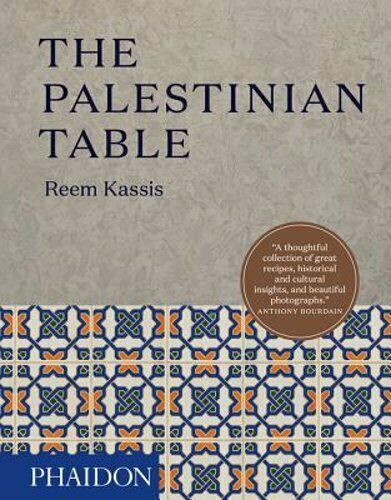
Reem Kassis’ first book came out in 2017. Her second, The Arabesque Table: Contemporary Recipes from the Arab World, debuts in March 2021.
“The worst part of hearing that I didn’t have a platform wasn’t the rain on my parade. It was not knowing what ‘platform’ even meant.
Dianne was kind enough to take me on and explain that platform meant owning a restaurant, or having a huge social media following – the kind of insurance policy agents and publishers look for before taking on a new author.
I was a stubborn child who always pushed boundaries. This streak came out in the process of trying to publish my first book. So even though I knew I didn’t have the requisite platform, I also knew I had a great idea and that I was willing to work hard to make it materialize. I researched, I wrote, I spoke to whoever would speak to me. Eventually I created an almost 100-page proposal (for a 250 page book!).
I had my pick of agents and signed with my first choice publisher. After a successful relationship with my publisher and agent, I asked what made them take the risk. ‘It was the proposal,’ my publisher said, ‘We could tell just by reading the recipes they would be delicious.’ My agent said, ‘It was your query email. Someone who could write that email could definitely write a book.’
The big elephant in the room may have been that I was ‘nobody.’ But when you have a good idea you truly believe in, and are willing to work hard to make it stand out from the rest, it usually comes across.
So if I have one word of advice to anyone trying to break into a sphere they are told they can’t break into, it’s that you have to work harder than your competition, because no amount of work is too much.
Also, read the acknowledgment sections of books you like. Research the agents so you can send them very targeted emails. Investigate publishers so you know where you have the best chance of being published and where would be the best fit given your topic. Research how to write a proposal and then get feedback on your work. Edit, edit, and re-edit.
And finally, don’t be afraid to ask. If you don’t, the answer is always no. If you do, it might be a yes.”
2. Belinda Smith Sullivan, author of Just Peachy.
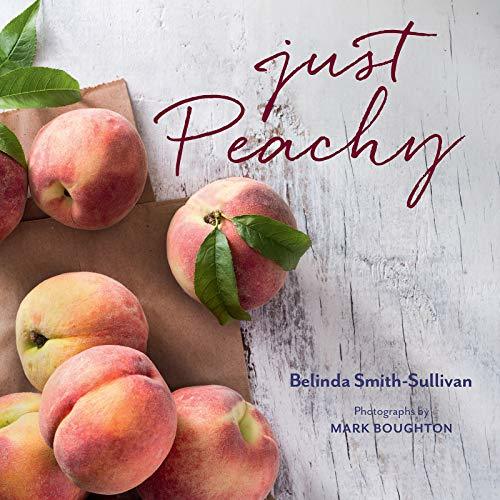
The first of what turns out to be a successful start for cookbook writing for Belinda Smith-Sullivan.
“I showed my first Just Peachy cookbook proposal to Bill LeBlond (then the senior editor of Chronicle Books, now retired). He told me I was not ready because I did not have a following. He even encouraged me to self-publish!
With that I just gave up. I sat on the cookbook proposal for about five years. Then I hired Dianne to coach me on it. She led me to an agent, and then I tried again.
When Michelle Branson of Gibbs Smith and I met in New York at the International Association of Culinary Professionals (IACP) annual conference to discuss my book idea, she said she liked my story and recipes. I think she was intrigued by my spice blends business and the fact that I’m a pilot. At the end of the day, I guess she thought I might make a good marketing story!
After Gibbs Smith published Just Peachy, I received an email from Bill informing me that he had purchased the book. He praised Gibbs Smith for taking a chance on me. My cookbook came out in 2019. My second cookbook for Gibbs Smith, Let’s Brunch, came out in 2020. I hope to write a third.
I don’t mind sharing my story at all. Especially if it helps someone else publish a cookbook. I guess I am the exception that proves the rule, but I never really quite understood what that means.
October 27, 2020
5 Tips for Successful Social Videos
According to Forbes.com, about half of consumers report they watch 5+ social videos online a day. As a visual species, humans are hard-wired to find videos more memorable and more popular than any other type of content.
Video as a means of storytelling and advertising is no longer simply an option for food professionals — it is an absolute necessity. If you’re a culinary professional, chef, blogger, cooking teacher, and/or cookbook author, social video gives you the opportunity to market not only yourself, but also cookbooks, blogs, products and cooking classes.
And people love to watch cooking videos and tips. Digital marketer Hubspot reports that YouTube survey participants say they primarily watch videos in order to “relax and unwind.” The number #2 reason is “to learn something new.” That couldn’t be more perfect for culinary professionals.
Also, social videos attract those influencer marketing dollars. So if you aren’t doing social videos, you need to, and if you are already doing them, you probably need to do more.
Social videos are short-form videos crafted specifically to drive engagement and captivate viewers on social networks. Social networks that feature social videos include
Facebook Live
IGTV
Instagram Reels
YouTube
TikTok.
These videos can be live, streaming, or pre-recorded. Each network requires somewhat different approaches due to video length constraints.
The most popular length for a video on YouTube is 15 minutes. But a cooking demo that runs 5 minutes or longer on YouTube or IGTV doesn’t work on TikTok, which caps videos at 15 seconds. Each platform and the story dictate the length. However, the universal truth for social videos is that it is modern storytelling. If the content is tight and compelling, people will watch.
Here’s how to make tight, compelling social videos:
1. Engage your audience right from the start.
Tell them what you are going to do for them right from the top, even before you introduce yourself! Tease them with what’s to come. Instead of “Hi, I’m Virginia Willis,” start with “Want to know the three secrets of how to make tender, perfect biscuits? Hi, I am Virginia Willis.”
2. Tell a story.
Every story needs a beginning, middle, and an end. Tell viewers what you are going to do, do it, and tell them what you did. Having a roadmap to follow will keep your audience engaged.
Once you’ve engaged them, tell them the secret and recap at the end. Visually, that means teasing with a beauty dish at the top, showing the steps to make it, and then revealing the hero once again at the end. This process is the same for any and all length of videos.
View this post on Instagram
A post shared by Virginia Willis (@virginiawillis) on Sep 18, 2020 at 12:33pm PDT
3. Practice and rehearse.
That food blogger who looks like a natural? That’s because she has practiced. Practice your intro. Practice your message points. Rehearse your actual segment. If you are cooking, set up a practice mise en place or even just “play act” your way through the segment. The key is knowing what you want to say long before the camera is running.
4. Build your tech toolbox.
Get started with a smartphone. Consumers are less and less worried about production values on social media and more concerned about content. You don’t have to have a ton of expensive equipment. One popular influencer I know taped his smartphone to his stove’s vent hood!
Determining the tools can be overwhelming. Having said that, you likely didn’t build your kitchen in one shopping trip. It’s the same with your tech toolbox. Build it piece by piece. Buy equipment that will last and you won’t have to replace it. A ring light and a tripod can take you far.
Here’s my most frequently used equipment (Disclosure: It’s an Amazon Affiliate storefront). B&H sells much of the same equipment for around the same price and cannot be beat for customer service. I’ve spent hours on the phone or chatting with them. You can tell them your budget and needs and they will direct you to what’s best for you.
5. End with a call to action.
Viewers want to know what is expected of them. Don’t miss the opportunity to further engage them. Tell them exactly what you want them to do, such as “Visit my website,” “Click on the link,” “Subscribe to my blog,” or “Buy my book.”
Social video is the easiest way to build a connection with your audience. With these 5 easy tips, you’ll build a brand your audience will know, like, and trust.
* * *
Virginia Willis is a Food Network Kitchen host, James Beard award-winning cookbook author, influencer, and content creator. She is also the co-founder of Culinary Media Training with Emmy-nominated producer and James Beard award-winning cookbook author Cynthia Graubart. For more information about social videos and services, please visit Culinary Media Training.
The post 5 Tips for Successful Social Videos appeared first on Dianne Jacob, Will Write For Food.
October 13, 2020
Dealing with the Inner Critic
 I was going to be on a panel at the International Association of Culinary Professionals (IACP) annual conference about dealing with the inner critic, but it got cut, so…more for you!
I was going to be on a panel at the International Association of Culinary Professionals (IACP) annual conference about dealing with the inner critic, but it got cut, so…more for you!
(And please check out the conference — it has a stellar and timely list of relevant sessions for writers, cooking teachers, bloggers and more.)
Anyway, I might do a webinar on this topic for IACP later, which would be great. And I’ve been thinking that, in the time of COVID, it never hurts to explore mental health. Often, creative people are sensitive, and in a time where it’s already hard to concentrate and focus, we don’t need unproductive thoughts. So let’s jump in.
What’s involved in dealing with the Inner Critic:
What is the inner critic, exactly?
It’s your own voice, first of all. It’s part of you. The critic can take the form of a destructive monologue, such as “That sentence is terrible, you are never going to be a good writer, no one wants your story ideas, you’re not going to get that cookbook deal….’ You know, the negative stuff in your head you try to ignore.
Are there different types?
Yes. The voice and messages are not the same for everyone.
Some researchers have identified seven types of inner critics:
the perfectionist
the taskmaster
the inner controller
the guilt tripper
the destroyer
the underminer
and the molder.
Do any of these sound familiar?
Isn’t negative self talk normal?
Yes, but too much can affect your confidence and self esteem. How much is too much? Do you feel depressed, angry, anxious or upset? Does your own brand of self talk reinforce feelings of shame and self doubt about your abilities as a writer, blogger, influencer, recipe tester, etc.?
If so, you need ways to tone it town. You don’t want your productivity to suffer, or reduce your chances of starting a new project, like a new cookbook or blog focus.
Because, let’s face it, we all have fears, and we try to cope with them. Maybe your Inner Critic is an overprotective parent that exhorts you to not start new writing projects for fear that you’ll be disappointed, for example.
Does the critic ever go away?
No. Because it’s part of you, you can’t get rid it. But you can tone it down.
Tips for dealing with the Inner Critic productively:
I’ve used a few techniques, over the years. These are the ones that have worked best for me:
1. Notice the chatter.
How often does this subconscious voice contact you with a negative message? If you’ve been dealing with the Inner Critic for years, you may not even notice. You try to block out the voice, but it’s still there.
2. Have a gentle talk.

Even if the critic seems creepy, you can still reach out and speak gently — even ask it for help.
Now that you’re paying attention, you might be shocked to see how often the critic pipes up with unwanted comments. Don’t yell at the Inner Critic when it appears. Treat the Inner Critic nicely, since it’s part of you. You want to quiet the voice, not destroy it. You could say, ‘Thank you, but I’m busy now. Could you come back later?”
3. Ask questions.
Research shows that talking to yourself can make you smarter, improve your memory, and help you focus. So don’t be shy. Address the Inner Critic as “you.” You could ask such things as:
What’s your role in my life?
What are you trying to protect me from?
What would happen if you didn’t do this job anymore?
You might be surprised by the answers, even have a breakthrough.
Lastly, there’s a silver lining for working with the critic. Being critical is a great skill! We all need an editor, for example. The Inner Critic is an expert at critical thinking. It can help you pick the best photo for Instagram, edit a blog post, review a recipe…all kinds of things that take discernment. Ask it for help with a task. And then train it to give you specific feedback, such as “crop out the fork,” or “tighten that sentence.” That’s so much more helpful than “What an awful photo!”
You want feedback that’s actually useful, versus a nagger who wants you to be perfect. Which is not how the Inner Critic sees itself, of course. It actually wants to be helpful. So train it to give you help that would be productive.
That’s it for my tips. Are you familiar with your Inner Critic? Have you tried other techniques? Let me know what has worked for you.
* * *
You might also like:
Top 3 Traits of Successful Artists and Writers
Feck Perfuction: Be Bold and Fearless with James Victore
(Photo by Priscilla Du Preez on Unsplash.)
The post Dealing with the Inner Critic appeared first on Dianne Jacob, Will Write For Food.
September 29, 2020
Black Women Editors in Food Writing to Follow Right Now
 You like to follow inspiring leaders and publications on social media, right? Do you know this group of Black women editors in food writing? The first three are new to their editorial positions, and the others are publishers who started their own magazines.
You like to follow inspiring leaders and publications on social media, right? Do you know this group of Black women editors in food writing? The first three are new to their editorial positions, and the others are publishers who started their own magazines.
Food writers and editors are mostly white. We need change in our industry. The women I’ve featured here are leading the charge, speaking out on the change they want to see, and making it. They cover stories that a white-dominated media overlooks. You’ll want to add them to your social media feed — and maybe you’ll want to pitch them story ideas as well.
So join me in celebrating these Black women editors in food writing:
1. The new editor-in-chief of Bon Appetit: Dawn Davis
Dawn Davis is a former vice president at Simon & Shuster (S&S). She accepted this new position and will start on November 2. Davis will be in charge of the print and digital formats of the magazine, as well as social media and video presence. Bon Appetit has 6.5 million monthly readers of the magazine.
While at S&S, Davis was publisher of Amistad Press, which is devoted to multicultural voices. She’s also the author of If You Can Stand the Heat: Tales from Chefs and Restaurateurs, a 1999 book featuring interviews with chefs.
So far I can’t find her on social media but I bet that will change soon.
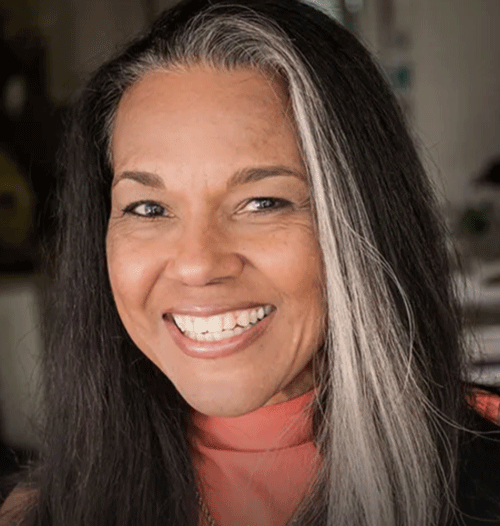
Toni Tipton-Martin, the new editor-in-chief of Cook’s Country magazine.
2. The new editor-in-chief of Cooks Country: Toni Tipton-Martin
Toni Tipton-Martin, a two-time James Beard Award winner for her books Jubilee: Recipes from Two Centuries of African American Cooking and The Jemima Code: Two Centuries of African American Cookbooks.
She started her career in journalism, and was the first African-American woman to hold the position of food editor at a major daily paper, the Cleveland Plain Dealer.
At Cook’s Country magazine, she will have her hands full. The magazine has a print circulation of 280,000. The Cook’s County television show is in its 13th season on public television. Two million viewers watch it every week.
Follow Toni on Twitter: @thejemimacode and Instagram: @tonitiptonmartin
I met Toni through the International Association of Culinary Professionals (IACP), at its annual conference in Austin a few years ago. Later we talked at another IACP conference, when she was about to start work on her second book.
I’d say something about pitching a story, but I don’t think American’s Test Kitchen (the parent company) uses outside writers. Maybe that will change under Toni.
3. The Philadelphia Inquirer‘s new food editor: Jamila Robinson
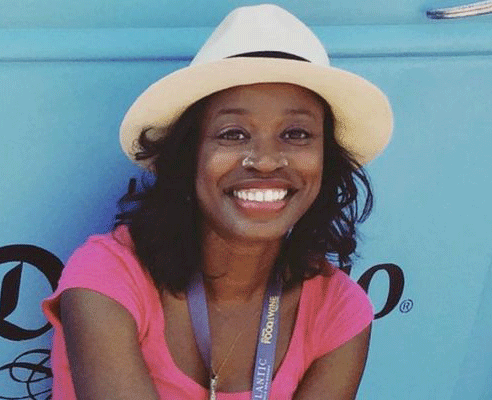
Jamila Robinson, editor of the Philadelphia Inquirer‘s food section.
Jamila Robinson was the editorial director for Atlantic 57, the creative and consulting division of The Atlantic. She took this job as the head of the food section in January.
In addition to assigning and editing articles, she also writes. Check out Romancing the Stove, which she wrote for Food & Wine.
She’s also the chair of the Beard media committee. Follow on Twitter: @JamilaRobinson Instagram: @jamilarobinson
4. The editor of Island and Spice magazine: Rochelle Oliver
Rochelle Oliver started the quarterly magazine Island and Spice to elevate the presentation of Caribbean food. It is focused on chefs and recipes, and aimed at a global audience. Most recently she was the breaking news copy editor and digital editor at The New York Times. Follow her on Twitter @Rochelle_Oliver and Instagram: @rororoc
And if you’d like to submit a story idea to Island and Spice, pitch editor AT islandandspice DOT com.
5. The editor and publisher of the online site Cuisine Noir: V. Sheree Williams
Cuisine Noir‘s mission is to connect the African diaspora through food, wine and travel, and to ensure the history, successes and achievements of Blacks in these industries. It debuted in October 2007. V. Sheree Williams is a content creator and consultant. Read about her on Korsha Wilson’s blog.
To pitch Cuisine Noir on a story idea, send an introductory email to request freelance guidelines at hello AT vsheree DOT com. Follow the magazine on Twitter @CuisineNoirMag and Instagram @CuisineNoirMag. I couldn’t find social media info for Wililams herself.
6. The editor of the forthcoming For the Culture magazine: Klancy Miller

Klancy Miller, a French-trained chef who is starting For the Culture magazine.
Klancy Miller, a cookbook author, writer and pastry chef, is starting the biannual For the Culture, a magazine that celebrates Black women in food and wine and food media. It will be written, photographed and ilustrated by Black women.
She crowdfunded $40,000 for the first issue. The theme of the first issue is “It’s personal.” To pitch the For the Culture, fill out this form.
Find Klancy Miller on Twitter @Klancycooks and on Instagram @Kancycooks.
* * *
Learn more about the changing face of food writing. Listen to these podcasts from Salt and Spine:
Food media led by non-white editors is paving the way for repesentative coverage
Building a more equitable cookbook industrywon’t be easy, but change is overdue
What can food media learn from the overdue reckoning at Bon Appetit
You might also like:
Julia Turshen on the Politics of Food and Writing
(Disclosure: This post contains affiliate links.)
The post Black Women Editors in Food Writing to Follow Right Now appeared first on Dianne Jacob, Will Write For Food.
September 18, 2020
Those Negative Thoughts While on Social Media
 You’re having one of those days where you get sucked into social media feeds. And you’re scrolling and clicking away, generating negative thoughts on what you’re seeing. Do you even notice?
You’re having one of those days where you get sucked into social media feeds. And you’re scrolling and clicking away, generating negative thoughts on what you’re seeing. Do you even notice?
That’s what I thought. Doing this has a name. It’s called negative thinking. Fancy stuff, eh?
Here are a few examples of negative thoughts while scrolling. It took me about five seconds to come up with this list, because I have negative thoughts too:
Everyone is doing better than I am
She got a book deal/big agent/award/big story published and I did not
I’m never going to be as good a photographer as she is
She has so many more followers than I do
He’s always so clever on Twitter and I’m not
So much is happening and I’m missing out.
Does this sound familiar? Especially now, when we aren’t having normal lives and there’s much more anxiety in our worlds. And, as you might imagine, negative thinking can be a soul suck.
I’m not talking about doomscrolling, which is when you keep surfing through depressing or sad news. It’s more about feeling envy, jealousy, or competitiveness.
But it’s not the end of the world to have negative thoughts. It’s not that hard to change a pattern that doesn’t serve you.
How do you deal with negative thoughts while on social media? Three ideas:
1. Notice them. That’s always the first step. If you don’t even notice that you’re beating yourself up with this negativity, you can’t make headway. You might get caught up in a cycle that leads to more negativity. But if you do notice, you can work on it and more easily let go of negative thoughts, or direct your attention elsewhere (Fun cat videos! Or actual work!).
2. Counter with positive thoughts. Instead of just negative thoughts, why not add some positive ones? High levels of positive thoughts correlate with higher levels of happiness. Do we compliment ourselves regularly? No. Try some of these: I’m doing so well with social media. I am not at the bottom of the pile. I have had three successes lately (name them).
You might not know what to say at first, or this might feel phony. That’s okay. Keep noticing and responding positively. You could also say, “So what if I don’t have the same size following?” or something like that.
3. Counter with gratitude. Be grateful for all you have achieved. If you have a bio somewhere, read it and be impressived with yourself. Appreciate the people who believe in you and love to respond to whatever you post.
That’s it. I’m no therapist, but doing these three things work for me. I learned them from a free online course I recommend all the time, called The Science of Happiness.
It’s worth trying to do something about your negative thinking patterns, because otherwise they can lead to burnout and decreased levels of self esteem. And I don’t know about you but I don’t need more issues to deal with this year!
What works for you? We could all use more tips these days.
* * *
You might also like: Who Thinks You’re a Good Writer?
(Photo by Priscilla Du Preez on Unsplash.)
The post Those Negative Thoughts While on Social Media appeared first on Dianne Jacob, Will Write For Food.
September 1, 2020
Recipes for Subversion: Women’s Suffrage Cookbooks Turn 100
 A guest post by Becky
Libourel Diamond
A guest post by Becky
Libourel Diamond
The year 2020 commemorates 100 years since the passage of the 19th Amendment, which secured women’s constitutional right to vote. The U.S. suffrage movement began in 1848, when women demanded the vote at the first women’s rights convention in Seneca Falls, NY. The battle continued for 72 years. Women lobbied, marched, picketed, and protested for the right to cast their say.
While these demonstrations are well documented, there were other, more subversive ways to spread their message: women’s suffrage cookbooks. These cookbooks were compilations of recipes submitted by women devoted to the cause and published by suffrage organizations. Cookbooks were a resourceful way to convey their argument, share information with other suffragettes, and help fund the movement.
Community cookbooks first emerged during the U.S. Civil War. They reflected life within a community, through both the recipes and other tips scattered throughout their pages. Typically, they provided advice about recipes, household tips and child rearing. Suffrage community cookbooks provided these suggestions. But they had another agenda too: getting women the right to vote.
Women’s suffrage cookbooks were perhaps one of the earliest media formats to realize the power of food as a marketing tool. Between 1886 and 1915, suffragettes used appealing cuisine to endorse the idea of women’s voting rights. They also wanted to win over those who did not see suffrage as a valid cause. According to Laura Kumin, author of All Stirred Up: Suffrage Cookbooks, Food, and the Battle for Women’s Right to Vote, “we’ll never know how many suffrage cookbooks there were, we only know of those that have survived – fewer than 10 today.”
Here’s more about the significance of women’s suffrage cookbooks and what they achieved:
1. They provided ways to exchange ideas and unite women.
Suffrage cookbooks were a uniting factor and a way to exchange ideas. They helped women rally together. But it was a subtle evolution. In The Woman Suffrage Cook Book (1886), Hattie A. Burr sandwiched period dishes such as Graham muffins, mock turtle soup, tomato pickle and Charlotte Russe between information about the movement. Recipe contributors featured prominent women’s rights leaders. There were also teachers, lecturers, physicians, ministers and authors. They sent the message that women could be creative, intellectual free thinkers. Five pages of quotes on “eminent opinions on women’s suffrage,” from Plato to Harriet Beecher Stowe, appeared at the end.
By the 20th century, women’s suffrage cookbooks became more brazen. A bold quote, strategically placed above the recipe for savory Brown Soup Stock in the Washington Women’s Cook Book (1909) explains: “The man who neglects to vote shows small interest in the welfare of his country and is not a good citizen. What shall we say of the patriotism of the woman who would not vote if she could?”
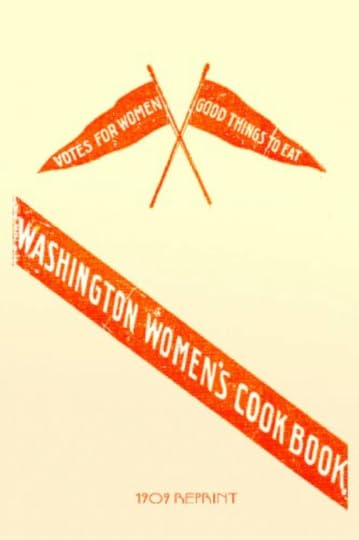
A collection of traditional and novel recipes punctuated with quotes supporting women’s right to vote, the Washington Women’s Cook Book (1909) was compiled by Linda Deziah Jennings and published by The Washington Equal Suffrage Association.
2. But there was little participation from diverse women.
Although there are recipes influenced by African American, Native American, Asian American and Mexican American cookery, evidence of suffrage cookbooks compiled solely by one of these communities is not apparent, making it seem likely that that the realm of suffrage cookbooks was limited to white women.
While not suffrage-themed, the closest connection is The Federation Cook Book (1910), a collection of recipes contributed by black women from California. It includes an introductory poem by Katherine D. Tillman, chairwoman of the National Association of Colored Women’s Clubs. The clubs formed in 1896. Its focus was on suffrage and ending racist policies and attacks.
Even though many black women were active in the suffrage movement, it wasn’t until the Voting Rights Act in 1965 when black women (and men) gained full voting rights. This legislation finally guaranteed Native Americans the right to vote. Asian Americans did not gain full access to citizenship and voting rights until 1952.
3. Recipes were practical but also innovative.
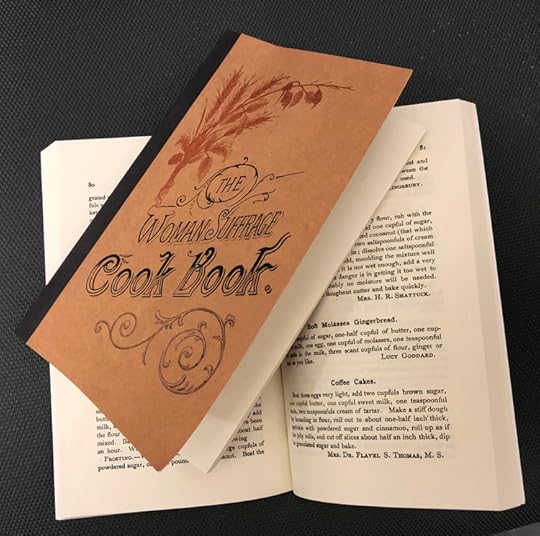
Published by Hattie A. Burr, The Woman Suffrage Cook Book was first sold at the Woman Suffrage Festival and Bazaar in Boston, a fundraiser held by the Massachusetts Woman Suffrage Association, in 1866.
These cookbooks not only focused on providing wholesome, healthful dishes, but were innovative as well. An example is the Rhubarb Toast submitted by Alice Stockham M.D. in The Woman Suffrage Cook Book. She calls it “an excellent breakfast dish.” It was more time consuming than today’s trendy avocado toast. The recipe calls for stewing 2 pounds of rhubarb with sugar and water before spreading it on hot buttered graham toast. Stockman further specified, “Never use white bread for toast, when bread of unbolted or entire wheat flour can be had.”

Compiled by Mrs. L.O. Kleber and published by The Equal Franchise Federation of Western Pennsylvania, The Suffrage Cook Book (1915) featured a cover showing Uncle Sam weighing men and women on his scales.
The Suffrage Cook Book (1915) discussed the now-popular vegan concept of using nuts as a meat substitute, both for cost savings and nutritive value. There were recipes such as Nut Roast, Nut Scrapple and Nut Turkey (predating Tofurky by 65 years!). There’s even an inventive use for Grape-Nuts cereal (introduced less than 10 years prior) in the Washington Women’s Cook Book. It was Grape-Nuts Broth, with directions to soak the cereal in warm milk, to make the hard nuggets more palatable.
4. Women coded messages into the recipes.
Suffrage cookbooks featured cuisine that reflected an era of American cookery such as salmon croquettes and pepper pot (which calls for knuckle of veal and four pounds of honeycomb tripe).
But there were also satirical recipes, such as Pie for a Suffragist’s Doubting Husband, which lists just one ingredient: 1 qt. milk human kindness, followed by eight reasons why: War, white slavery, child labor, 8,000,000 working women, bad roads, poisonous water and impure food. The directions state to “mix the crust with tact and velvet gloves, using no sarcasm, especially with the upper crust.”
There’s a recipe for Scripture Cake. It matches real ingredients such as butter, flour, sugar, raisins and figs to books of the Bible, with directions to “follow Solomon’s advice for making good boys, and you will have a good cake.”
5. Women’s suffrage cookbooks acknowledged women outside the home.
The success of suffrage cookbooks proved that women could have an active domestic role and do meaningful work outside the home. This often meant pooling their resources. As noted in The Rider University Women’s Suffrage Centennial Cookbook, early suffrage leaders Elizabeth Cady Stanton and Susan B. Anthony worked together to spread their message. “With seven children, Stanton juggled her responsibilities … she wrote speeches that Anthony would go out and deliver, while Anthony helped her at home.”
The women’s suffrage cookbooks gave women more avenues and exposure. According to culinary archivist Jan Longone, they were sold at fairs, bazaars and women’s exchanges. This not only raised funds for the suffrage movement, but also helping women network and gain new skills in the fields of publishing, advertising and sales.
Today women continue to balance a seemingly endless series of tasks. But thanks to the determined suffragettes who spread the word through many different forums, including cookbooks, women are now able to share their voice and opinion through the vote.
* * *
Food writer, librarian and research historian Becky Libourel Diamond is the author of The Thousand Dollar Dinner and Mrs. Goodfellow: The Story of America’s First Cooking School. She recently contributed to The Rider University Women’s Suffrage Centennial Cookbook, a community cookbook dedicated to the vote, with proceeds helping fund scholarship assistance for women students attending Rider. Her current projects include a book about the history of processed food, and a Delmonico’s-themed entertainment cookbook with fellow epicurean Max Tucci.
* * *
You might also like:
How Suffragists Used Cookbooks As A Recipe For Subversion
The Woman Suffrage Cook Book Prints Recipes for Subversion
The post Recipes for Subversion: Women’s Suffrage Cookbooks Turn 100 appeared first on Dianne Jacob, Will Write For Food.
August 18, 2020
What’s Happening in Food Writing? 28 Can’t Miss LInks
 Who has time to keep up with what’s happening in food writing? There’s so much: the Bon Appetit scandal, the Los Angeles Times scandal, plus trends and essays related to all kinds of topics, including justice issues and food history.
Who has time to keep up with what’s happening in food writing? There’s so much: the Bon Appetit scandal, the Los Angeles Times scandal, plus trends and essays related to all kinds of topics, including justice issues and food history.
Well, I do. It’s my job, as the author of Will Write for Food and this blog. And now you can see what all the excitement is about on social media, because you don’t have to search. I’ve collected recent best links on what’s happening in food writing, all in one place. I threw in a few helpful links as well about career and social media. We all need those!
These links come from my bi-monthly newsletter aimed at food writers and bloggers, which you can subscribe to for free. You’ll also get a copy of my short e-book, “The 15 Biggest Errors to Avoid When Writing Recipes.”
My newsletter subscribers are a valuable asset. As a result, I give them access to certain events and information first, before I broadcast them on social media.
And if you’re already a newsletter subscriber, thank you. I bet you haven’t opened all of these. Take a second look. There’s lots her about food media, food history, equity issues, and amping up your skills.
So pull up a chair and read what’s happening in food writing:
The Future of Food Media Is in Your Inbox. The rise of indie newsletters as a way for freelancers to circumvent traditional media and create an income.
A spate of new food memoirs promised something different. But the lack of diversity is the same old story. Publishing gatekeepers have prioritized memoirs by white women.
Bon Appétit editor Alex Delany has apologized following his coworkers’ departure from the publication’s YouTube channel. Here’s how allegations of a ‘toxic’ work culture left the magazine in chaos. If you’re not up on what’s happened, here’s a round-up article with the world’s longest title.
The 9 Best YouTube Keyword Tools in 2020. Get your tech hat on to understand the right keywords for YouTube.
Why I No Longer Support Bob’s Red Mill. YouTube videos, Part I and Part II, about a Black food blogger’s experience of trying to work with the company. (Thanks to Calysta Watson for notifying me.)
Jump Right In: A New Tool for Historical Research Using Cookbooks. Rachel Laudan looks at the history of The Sifter, a new editable food history database.
Building Thought Leadership with Content. I know, this isn’t the usual link. But here’s a report that will tell you if your own marketing works. Guess what’s working best? Video. Guess which media comes in last? Spoiler alert: podcasts.
Australian food writers call for greater diversity of voices in wake of New York Times durian debacle. Just shameful, to describe Asian fruits this way.
Substack Podcast #021: Cookbooks with Paula Forbes. If you want to write a cookbook, you need to listen to this podcast. Or read the transcript.
How Food Media Created Monsters in the Kitchen. The rise of the toxic celebrity chef is the fault of journalists, says this author.
The Color of My Skin Is Sometimes Confused With the Scope of My Talent. When writers of color are asked to write about the food of their heritage.
There’s No I in Jam: Sqirl Wrestles With the Sticky Question of Who Really Owns a Recipe. Whether staff should get credit.
How to Sell Books in 2020: Put Them Near the Toilet Paper. (NY Times possible paywall). Book sales jumped this spring at big box stores.
Food Photography Didn’t Start on Instagram—Here’s Its 170-Year History. A review of Feast for the Eyes , about the history of photographing food.
New e-book series features recipes from Mexican Cookbook Collection. Historical digital mini-cookbooks made by librarians.
Butt Types. An animated look through fonts, expressed as buttocks. Thanks to Carolyn Phillips.
LA Times Food Editor Peter Meehan Resigns After Sexual Harassment Accusations. He made $300k at this job. That blows my mind.
Osayi Endolyn’s sample resignation letter for top people in publishing.. She’s helping them step down.
The Racist History of Tipping. The moral: We need to get rid of the subminimum wage. Even minimum wage is too low.
How Book Publishers Decided To Move Publication Dates During The COVID-19 Pandemic. “The trick was to release them early enough to avoid the wash of election coverage, while not crowding our fall season with too many simultaneous publications.”
Wiki training workshop – Roberta Wedge. This was one of my favorite talks at the Oxford Symposium last year, about how to contribute to Wikipedia.
Derbyshire blind chef pens cookbook for the visually-impaired. A great way to support blind people who love to cook.
Sold: A Black Texan Trailblazer’s ‘Treasure Chest’ of Recipes. Her recipe boxes are sought after.
What do we lose when calling paratha “flaky bread?”
The 10 Best Cookbooks of 2020…So Far. Food52 weighs in.
Epicurious and Well-Equipped Pitching Guidelines. Want to write for Epicurious? Here’s an updated guide.
A New Food Magazine ‘to Celebrate, Highlight & See Black Women. The first food magazine solely focused on and created by Black women.
When Did Recipe Writing Get So…Whitewashed? Priya Krishna and Yewande Komolafe discuss.
I hope this list is worth your time, and I appreciate your investment. Sign up for my free newsletter, and get these in your inbox twice a month. Thank you!
The post What’s Happening in Food Writing? 28 Can’t Miss LInks appeared first on Dianne Jacob, Will Write For Food.
August 4, 2020
5 Ways to Up Your Twitter Following and Engagement
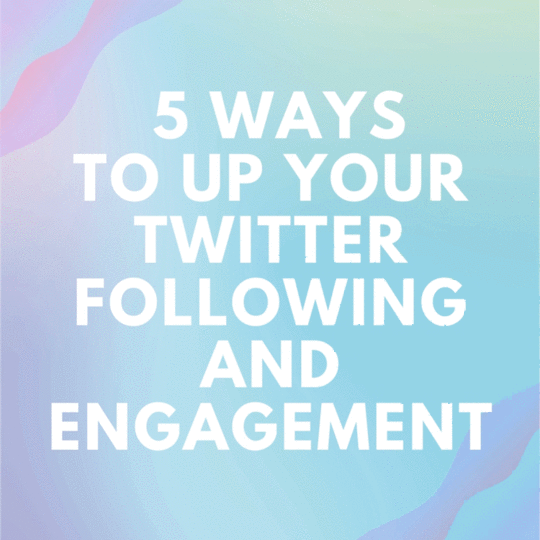 A guest post by Nandita Iyer/Saffron Trail
A guest post by Nandita Iyer/Saffron Trail
Twitter is the place for all the latest news, trends and memes. It the one place to stay updated on topics that are important to you. That said, it is also a platform that takes time to grow on you. Many people find Twitter intimidating, either because it’s too noisy or they feel stumped on how to use it.
What is the right kind of content to share on Twitter? How can you use Twitter to drive traffic to your website, build your brand, and increase your book sales or newsletter sign-ups?
I’ve used Twitter successfully for over a decade, and I’m sharing 5 tips to help you up your Twitter following and engagement:
1. Work that bio.
Apart from a profile photo, header photo, name, location and website link, Twitter allows you 160 characters to write something about yourself. Use the words in your profile wisely. Humblebrags, humour, call to action, emojis, hashtags – use any or all in the right measure to ensure your profile reads like an elevator pitch with a hearty dose of personality.

While you could use the header image space to show off your cute kittens (or if you’re like me, a favourite Studio Ghibli scene), it is a great way to announce an upcoming book or event.
Bonus tip: If you want more than 160 characters to describe all that you do, put it in a pinned tweet (280 characters), which stays at the top of your tweets. For the longest time, my pinned tweet was the preorder link of my first book and it really helped me get the visibility and clicks.
2. Promote your Twitter handle.
Now that you have a Twitter handle, let the world know about it. Share it in your email signatures, other social media profiles, columns and articles in print media, as well as online and in the ‘about me’ section of your blog or book.
Embed your relevant tweets in blogs or articles online, so the people who visit the blog or website can also choose to follow you on Twitter. Here’s an example:
Performed a surgery on my dining table this morning pic.twitter.com/mtG0D6rJPG
— Nandita Iyer (@saffrontrail) July 21, 2020
3. Get lots more social.
Follow and interact with people and accounts from your niche. Follow your peers, top food publications, editors, chefs, restaurants, markets and so on. Reading the tweets alone gives plenty of insights, perspectives and understanding into our industry. Reply to tweets that resonate with you, whether you agree or disagree. Add your thoughts and insights.
The beauty of Twitter is that you never have to feel embarrassed about butting into a conversation with strangers. In fact, that is the whole point of this platform. Sometimes, a witty reply to a celebrity tweet ends up getting 1000s of likes and retweets.
Retweeting (RT), or retweeting with your own words added are two more ways of interacting with accounts.
Bonus tip: If you follow hundreds of accounts, make a Twitter list of the few accounts that you consider the most relevant or important. Follow this list instead of your entire timeline for a more concentrated source of information. You can choose to keep this list public or private.
4. Tweet a variety of content.
The question of what to tweet plagued me in my early Twitter days. It took a while to find my groove, understand the type of content I like to share, and what my audience likes to consume.
Currently Twitter allows you to post text, polls, images, videos as well as voice tweets. You can be as opinionated as you like on Twitter. Edgy tweets about current topics get a lot of eyeballs.
Use the text space to tweet a recipe, along with a photo of the dish. Start the tweet and then continue the recipe step-by-step recipe as a thread of tweets. Cooking tips are useful and readers always appreciate them.
Behind-the-scenes photos and videos of your work — be it writing, photography or cooking — help keep your content interesting.
Short videos of food prep or the recipe preparation itself are a great way to gain engagement while sharing useful information. Polls help you gauge audience preferences. By all means, use Twitter to share links of your latest columns or blogs, but they should not be the only thing you share.
What’s your favourite cream biscuit? Vote below or comment if any other!
— Nandita Iyer (@saffrontrail) July 6, 2020
In short, use your tweets to build your online personality and brand, and show your expertise. Help people with that expertise.
After years of self control, finally gave in and bought a waffle maker. Weekend breakfasts are set.
From the test run this morning – Oat cinnamon waffles

 By
By 


